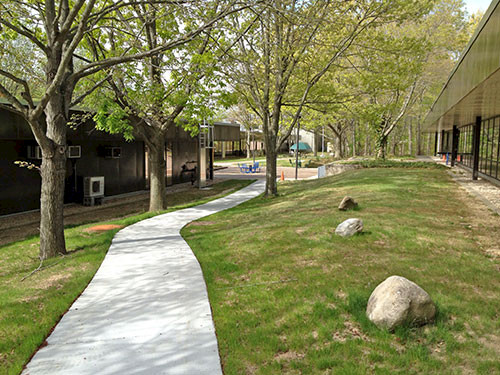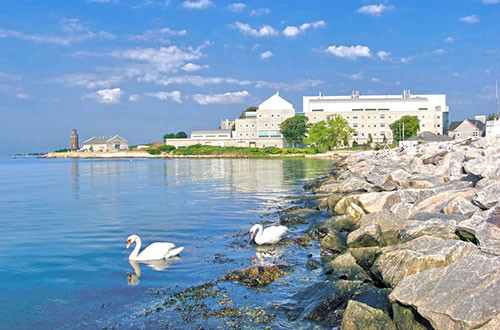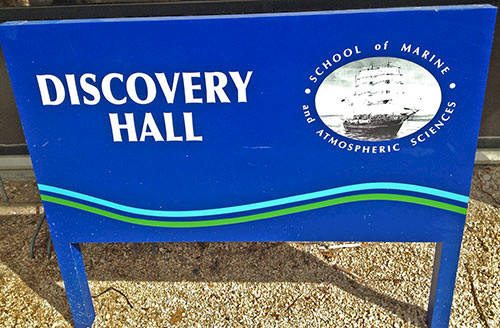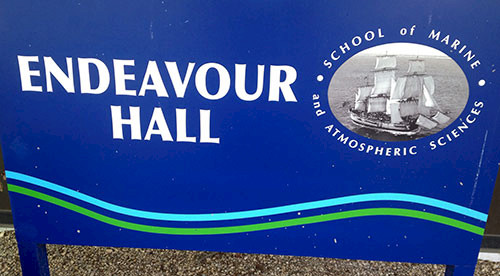Dr. Christine O'Connell's dissertation defense conclusion = Long Island Sound should be called 'Connecticut Sound'
Bill Dennison ·I traveled to Stony Brook University on Long Island for Christine O'Connell's dissertation defense at the School of Marine and Atmospheric Science (SoMAS) on May 6. Christine presented the results of her survey on stakeholder perceptions of Long Island Sound. She did a wonderful job analyzing and teasing apart the survey results. It was clear that Connecticut people had a much keener interest in Long Island Sound than New Yorkers. The Connecticut coastline is characterized as a 'working coastline', referring to the industry, shipping, fishing, recreational, power generation, military and other activities along Long Island Sound. The New York coastline is largely residential, with fewer harbors. Long Island Sound is much more accessible from Connecticut, with highways, railroads and various state parks providing vistas and access to the Sound. The Long Island side, however, has fewer vistas and limited access. Even the state marine labs differ in access to Long Island Sound: the University of Connecticut is located at Avery Point right on the water in Groton. SoMAS is nestled in the woods on the north shore of Long Island, somewhat distant from the water.


Connecticut's only ocean access is Long Island Sound. In contrast, Long Island has many other water bodies, including New York Bight, the south shore embayments (e.g., Jamaica, Oyster, Great South, Moriches, Shinnecock Bays), the east end embayments (e.g., Great Peconic, Little Peconic, Gardiners Bays), as well as the Atlantic Ocean beaches. It reminded me of the joke that Paul Greenfield likes to tell about the breakfast plate with eggs and bacon. To produce this breakfast, the chicken (aka, Long Island) is engaged, but the pig (aka, Connecticut) is committed. This 'commitment' by Connecticut people suggests that Long Island Sound is misnamed and should be 'Connecticut Sound'.
Traveling to Stony Brook for a seminar was an interesting time travel journey. I first arrived at Stony Brook almost three decades ago, beginning my postdoctoral stint as Coastal Marine Scholar in 1984. My fellow Coastal Marine Scholar was Carmela Cuomo, also a recently minted PhD, and we both served on Christine's thesis committee. Two other committee members were at Stony Brook when Carmela and I arrived; Drs. Jerry Schubel and David Conover. Jerry was the Director of what was called Marine Science Research Center (MSRC) at the State University of New York at Stony Brook (now Stony Brook University) when we arrived. Jerry moved to head up the New England Aquarium and then onto the Aquarium of the Pacific in Long Beach, California where he currently serves as Director. Dave Conover also was Director of MSRC, now School of Marine and Atmospheric Science (SoMAS) before joining the National Science Foundation where he is the Division Director for Ocean Sciences. Jerry and David were calling in from California and Washington, D.C., respectively and their voices boomed into the seminar room where Christine's oral examination took place. When Jerry began speaking, Carmela and I simultaneously had the same thought--it sounded like God (our former boss) was speaking to us.
I appreciated the nice signs in front of the SoMAS buildings. When I first arrived in 1984, the buildings were denoted as letters, 'Building J', for example. Several of us lobbied to change the building names to appropriate marine science names. We settled on names of famous oceanographic vessels; Endeavour, Challenger, Dana and Discovery. I recall a special seminar in which we described each of these ships in turn. Dr. Malcolm Bowman, a native New Zealander, described the HMS (Her Majesty's Ship) Endeavour. This was appropriate since the British Captain James Cook discovered and mapped New Zealand in 1769 aboard the Endeavour before he went on to the east coast of Australia in 1770. Dr. Ed Carpenter described the HMS Challenger, the British ship that conducted the first oceanographic expedition of the world's oceans between 1872-1876 for the Royal Society of London. Dr. Glenn Lopez who studied in Denmark described the Dana, on which Johannes Schmidt led on the Dana expeditions in 1921-1922 to the South Atlantic Ocean, funded by the Carlsberg Foundation. I described the RRS (Royal Research Ship) Discovery, which was named after the various British ships named HMS Discovery. The HMS Discovery was one of Captain Cook's ships on his third and final voyage. Another HMS Discovery was captained by George Vancouver on his voyage of discovery to the Pacific Northwest. The HMS Discovery was used by polar explorers Robert Falcon Scott and Ernest Shackleton in the Discovery Expedition of 1901-1904 before being re-designated RRS Discovery. We were very proud of having chosen these apropos names, but were crushed when someone overheard the librarians on the main campus of Stony Brook talking about our building names. They said "Those marine scientists are so modern, naming their buildings after the space shuttles". Many years later, I watched a marine biologist turned astronaut Ricky Arnold get launched into space aboard the Space Shuttle Discovery, so I suppose the librarians were prescient after all!


About the author
Bill Dennison

Dr. Bill Dennison is a Professor of Marine Science and Interim President at the University of Maryland Center for Environmental Science (UMCES).